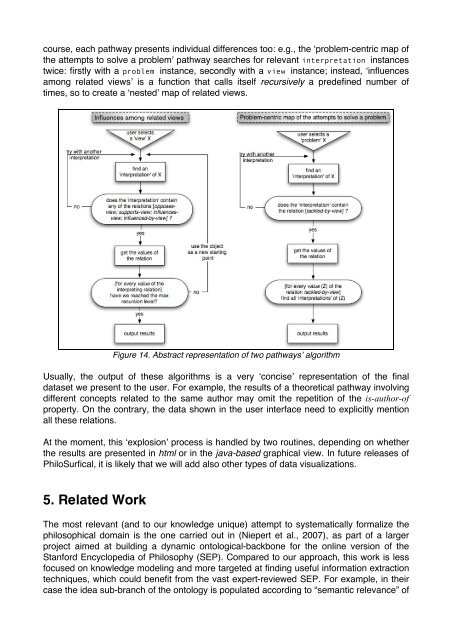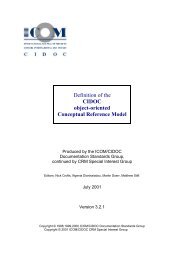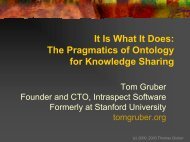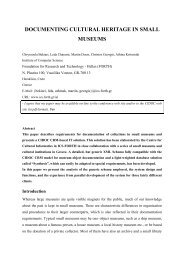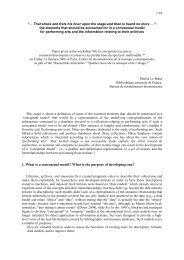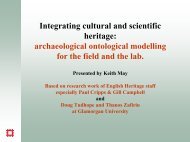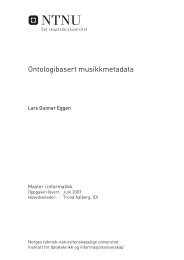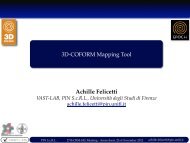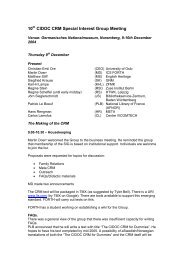course, each pathway presents individual differences too: e.g., the ʻproblem-centric map ofthe attempts to solve a problemʼ pathway searches <strong>for</strong> relevant interpretation instancestwice: firstly with a problem instance, secondly with a view instance; instead, ʻinfluencesamong related viewsʼ is a function that calls itself recursively a predefined number oftimes, so to create a ʻnestedʼ map of related views.Figure 14. Abstract representation of two pathwaysʼ algorithmUsually, the output of these algorithms is a very ʻconciseʼ representation of the finaldataset we present to the user. For example, the results of a theoretical pathway involvingdifferent concepts related to the same author may omit the repetition of the is-author-ofproperty. On the contrary, the data shown in the user interface need to explicitly mentionall these relations.At the moment, this ʻexplosionʼ process is h<strong>and</strong>led by two routines, depending on whetherthe results are presented in html or in the java-based graphical view. In future releases ofPhiloSurfical, it is likely that we will add also other types of data visualizations.5. Related Work<strong>The</strong> most relevant (<strong>and</strong> to our knowledge unique) attempt to systematically <strong>for</strong>malize thephilosophical domain is the one carried out in (Niepert et al., 2007), as part of a largerproject aimed at building a dynamic ontological-backbone <strong>for</strong> the online version of theStan<strong>for</strong>d Encyclopedia of Philosophy (SEP). Compared to our approach, this work is lessfocused on knowledge modeling <strong>and</strong> more targeted at finding useful in<strong>for</strong>mation extractiontechniques, which could benefit from the vast expert-reviewed SEP. For example, in theircase the idea sub-branch of the ontology is populated according to “semantic relevance” of
ideas (based on words co-occurrence), instead of trying to model a hierarchy of types.<strong>The</strong>re<strong>for</strong>e, we see the two approached as fundamentally complementary <strong>and</strong> likely to beused together in future work.As various publications suggest, the humanities computing community has recently beenmore interested in the usage of ontologies <strong>for</strong> facilitating data representation <strong>and</strong>exchange (Gábor Nagypál <strong>and</strong> Oosthoek, 2005,Vieira <strong>and</strong> Ciula, 2007). In this context, theDiscovery project (2008) st<strong>and</strong>s out <strong>for</strong> its explicit goal of creating a Semantic Webinfrastructure specifically <strong>for</strong> philosophers. From the ontological point of view, the authorsplan to use a ʻnetworkʼ of ontologies (Nucci et al., 2007). This seems really promising, butun<strong>for</strong>tunately at the time of writing there is still no publicly available ontology <strong>for</strong> thephilosophical domain. We plan to investigate how our results compare with theirs as soonas they will make them available.Regarding the <strong>for</strong>malization of ideas (<strong>and</strong> especially philosophical ideas) we found noevidence of relevant work in the knowledge representation research literature. Althoughmodels such as Wordnet (Fellbaum, 1998) <strong>and</strong> Cyc (Lenat <strong>and</strong> Guha, 1990) have in theirknowledge-base philosophy-related concepts, they present them in hierarchies that areeither too flat (e.g. everything is a subclass of “doctrine”) or not complex enough to supportany navigation mechanism. <strong>The</strong> noteworthy exception here is the DnS module of Dolce(Gangemi <strong>and</strong> Mika, 2003), which is “intended to provide a framework <strong>for</strong> representingcontexts, methods, norms, theories, situations”, <strong>and</strong> has strongly influenced us. However,our ontology appears to be much more specifically suited to represent philosophicalentities, such as schools of thoughts or problems. In fact, such topics are only marginallytreated by DnS, which focuses on the <strong>for</strong>malization of entities such as plans, laws <strong>and</strong>regulations (legal objects). Furthermore, our <strong>for</strong>malization of fields of studies (cf. section3.2) could be related to the various work done in digital libraries subjectsʼ classification.Although we come from a different perspective, we acknowledge that approaches such asthe mereotopological one (Welty <strong>and</strong> Jenkins, 1999) could be well suited also <strong>for</strong> thephilosophical domain. We plan to investigate further this issue in future work.Finally, it is worth mentioning recent research aimed at facilitating the semantic navigationof digital resourcesʼ repositories, <strong>for</strong> it complements our learning-pathways approach.Faceted browsing systems usually provide generic architectures that aim at letting usersexplore potentially unfamiliar domains in a gradual <strong>and</strong> incremental manner. <strong>The</strong>seapproaches, inspired by faceted theory (Ranganathan, 1990), have been tested in varioushumanities domains, such as classical music (Schraefel et al., 2005), visual arts(Hildebr<strong>and</strong> et al., 2006), cultural heritage (Hyvönen et al., 2008) <strong>and</strong> literature (Nowviskie,2005). In general, by means of highly interactive visualization mechanisms which arecontrolled by the userʼs selection of facets, the structure of a domain can be disclosed in avery intuitive manner. <strong>The</strong> main limitations of these systems, in our opinion, is linked totheir very best feature. That is, being largely non-domain specific <strong>and</strong> allowing navigationbased on ʻsmallʼ <strong>and</strong> ʻincrementalʼ steps (i.e. selection of views/facets) the navigationmechanisms can hardly be tailored to specific learnersʼ needs. For instance, it would notbe possible to construct a ʻviewʼ which organizes resources in a way that mimics, or atleast supports, the traditional ways a discipline is presented or taught. In conclusion, ournarrative inspired approach seems to be better targeted to an educational scenario.


